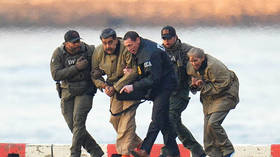US, Chinese warships nearly collide in South China Sea

Tensions in East Asia spiked once again when a Chinese naval vessel attempted to stop a US guided missile warship in international waters in early December.
According to American defense officials, the USS Cowpens was conducting surveillance of Beijing’s new aircraft carrier, the Liaoning, when Chinese warships ordered it to stop in its tracks.
However, the Cowpens refused to comply with the order because it was in international waters. When Chinese ships responded by moving in front of the Cowpens and stopping in front of its route, the American vessel was forced to take evasive maneuvers to avoid a collision.
“On December 5th, while lawfully operating in international waters in the South China Sea, USS Cowpens and a PLA Navy vessel had an encounter that required maneuvering to avoid a collision,” a Navy official told the Washington Free Beacon.
“This incident underscores the need to ensure the highest standards of professional seamanship, including communications between vessels, to mitigate the risk of an unintended incident or mishap.”
The Free Beacon also reported that official protests have been filed by the US government in Washington and Beijing, through both diplomatic and military channels.
According to military affairs expert Rick Fisher, the incident demonstrates that after two decades of building up its naval presence, China feels comfortable indicating that it will not accept an American presence in its region of influence.
“In this early stage of using its newly acquired naval power, China is posturing and bullying, but China is also looking for a fight, a battle that will cow the Americans, the Japanese, and the Filipinos,” he said to the Free Beacon. In order to maintain stability, he suggested that the US and Japan heavily guard the Senkaku Islands - which China also claims under the name 'Daioyu' - and refortify the Philippines.
The latest standoff between China and the US comes just a few weeks after Beijing declared a new air defense identification zone (ADIZ) in the East China Sea. The ADIZ included the Senkaku/Daioyu Islands, and required all aircraft flying through to notify China of their plans in advance.
The United States and Japan both stated they will not recognize the new zone, with the US flying two B-52 bombers into the area without notifying China of their presence. The US has, however, advised domestic airlines to comply with China’s requests for safety reasons.
Concerned that China’s ADIZ has Seoul in its crosshairs, South Korea recently expanded its air defense zone as well. The new zone places the disputed Leodo rock formation under Korean airspace. Beijing also lays claim to this area, which it calls the 'Suyan.'
While President Barack Obama’s administration has repeatedly denied that it wants to contain China’s rise, Beijing is concerned that the US is attempting to surround the country with an allied front that includes the likes of Japan, India, and the Philippines. Earlier this year, Obama met with Chinese President Xi Jinping and the two leaders declared the need to forge a relationship that avoids a Cold War mentality from forming between the countries.














